
The chapter sections to review are shown in parentheses at the end of each problem.
Use the following diagram tor problems 5.77 and 5.78:
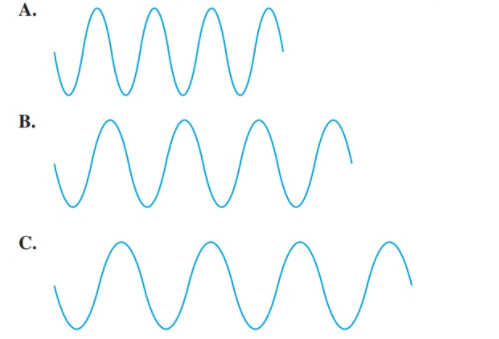
Select diagram A, B, or C that (5.1)
a. has the longest wavelength
b. has the shortest wavelength
c. has the highest frequency
d. has the lowest frequency
(a)
Interpretation:
The diagram having the longest wavelength should be selected.
Concept Introduction:The distance between two successive identical parts of the wave (from successive trough to trough or crest to crest) is said to be the wavelength.
Answer to Problem 77UTC
C.
Explanation of Solution
Given:
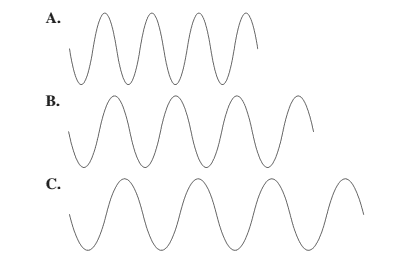
Larger the distance between the successive crest to crest or trough to trough, larger is the wavelength.
Among the given waves, the distance between successive crest to crest of wave C is largest so, the wavelength of wave C is longest.
(b)
Interpretation:
The diagram having the shortest wavelength should be selected.
Concept Introduction: The distance between two successive identical parts of the wave (from successive trough to trough or crest to crest) is said to be the wavelength.
Answer to Problem 77UTC
A.
Explanation of Solution
Given:
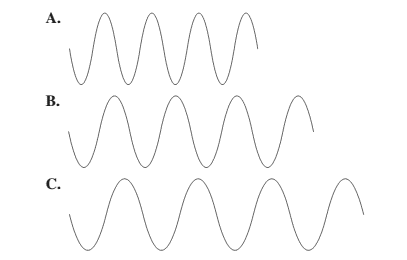
Smaller the distance between the successive crest to crest or trough to trough, smaller is the wavelength.
Among the given waves, the distance between successive crest to crest of wave A is smallest so, the wavelength of wave A is shortest.
(c)
Interpretation:
The diagram having the highest frequency should be selected.
Concept Introduction: The relationship between wavelength and frequency is given as:
Where
Answer to Problem 77UTC
A.
Explanation of Solution
Given:
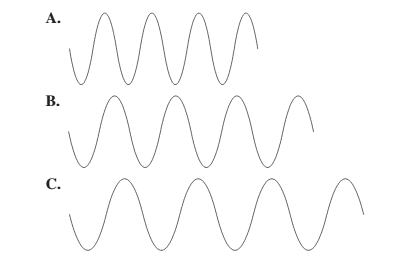
There is a relationship between wavelength and frequency that is they are inversely proportional to each other. Higher the value of wavelength, lower will be the frequency and vice-versa.
Thus, wave A will have highest frequency.
(d)
Interpretation:
The diagram having the lowest frequency should be selected.
Concept Introduction: The relationship between wavelength and frequency is given as:
Where
Answer to Problem 77UTC
C.
Explanation of Solution
Given:
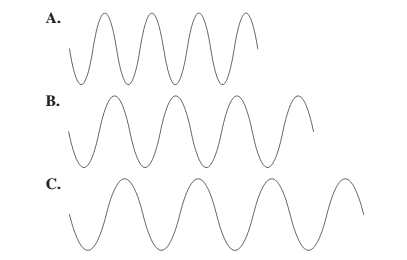
There is a relationship between wavelength and frequency that is they are inversely proportional to each other. Lower the value of wavelength, higher will be the frequency and vice-versa.
Thus, wave C will have lowest frequency.
Want to see more full solutions like this?
Chapter 5 Solutions
Basic Chemistry
- 2. Provide reagents/conditions to accomplish the following syntheses. More than one step is required in some cases. a. CH3arrow_forwardIdentify and provide an explanation that distinguishes a qualitative and quantitative chemical analysis. Provide examples.arrow_forwardIdentify and provide an explanation of the operational principles behind a Atomic Absorption Spectrometer (AAS). List the steps involved.arrow_forward
- Instructions: Complete the questions in the space provided. Show all your work 1. You are trying to determine the rate law expression for a reaction that you are completing at 25°C. You measure the initial reaction rate and the starting concentrations of the reactions for 4 trials. BrO³¯ (aq) + 5Br¯ (aq) + 6H* (aq) → 3Br₂ (l) + 3H2O (l) Initial rate Trial [BrO3] [H*] [Br] (mol/L) (mol/L) | (mol/L) (mol/L.s) 1 0.10 0.10 0.10 8.0 2 0.20 0.10 0.10 16 3 0.10 0.20 0.10 16 4 0.10 0.10 0.20 32 a. Based on the above data what is the rate law expression? b. Solve for the value of k (make sure to include proper units) 2. The proposed reaction mechanism is as follows: i. ii. BrО¸¯ (aq) + H+ (aq) → HBrO3 (aq) HBrO³ (aq) + H* (aq) → H₂BrO3* (aq) iii. H₂BrO³* (aq) + Br¯ (aq) → Br₂O₂ (aq) + H2O (l) [Fast] [Medium] [Slow] iv. Br₂O₂ (aq) + 4H*(aq) + 4Br(aq) → 3Br₂ (l) + H2O (l) [Fast] Evaluate the validity of this proposed reaction. Justify your answer.arrow_forwardе. Д CH3 D*, D20arrow_forwardC. NaOMe, Br Brarrow_forward
- Please predict the products for each of the following reactions: 1.03 2. H₂O NaNH, 1. n-BuLi 2. Mel A H₂ 10 9 0 H2SO4, H₂O HgSO4 Pd or Pt (catalyst) B 9 2 n-BuLi ♡ D2 (deuterium) Lindlar's Catalyst 1. NaNH2 2. EtBr Na, ND3 (deuterium) 2. H₂O2, NaOH 1. (Sia)2BH с Darrow_forwardin the scope of ontario SCH4U grade 12 course, please show ALL workarrow_forwardIs the chemical reaction CuCl42-(green) + 4H2O <==> Cu(H2O)42+(blue) + 4Cl- exothermic or endothermic?arrow_forward
 ChemistryChemistryISBN:9781305957404Author:Steven S. Zumdahl, Susan A. Zumdahl, Donald J. DeCostePublisher:Cengage Learning
ChemistryChemistryISBN:9781305957404Author:Steven S. Zumdahl, Susan A. Zumdahl, Donald J. DeCostePublisher:Cengage Learning ChemistryChemistryISBN:9781259911156Author:Raymond Chang Dr., Jason Overby ProfessorPublisher:McGraw-Hill Education
ChemistryChemistryISBN:9781259911156Author:Raymond Chang Dr., Jason Overby ProfessorPublisher:McGraw-Hill Education Principles of Instrumental AnalysisChemistryISBN:9781305577213Author:Douglas A. Skoog, F. James Holler, Stanley R. CrouchPublisher:Cengage Learning
Principles of Instrumental AnalysisChemistryISBN:9781305577213Author:Douglas A. Skoog, F. James Holler, Stanley R. CrouchPublisher:Cengage Learning Organic ChemistryChemistryISBN:9780078021558Author:Janice Gorzynski Smith Dr.Publisher:McGraw-Hill Education
Organic ChemistryChemistryISBN:9780078021558Author:Janice Gorzynski Smith Dr.Publisher:McGraw-Hill Education Chemistry: Principles and ReactionsChemistryISBN:9781305079373Author:William L. Masterton, Cecile N. HurleyPublisher:Cengage Learning
Chemistry: Principles and ReactionsChemistryISBN:9781305079373Author:William L. Masterton, Cecile N. HurleyPublisher:Cengage Learning Elementary Principles of Chemical Processes, Bind...ChemistryISBN:9781118431221Author:Richard M. Felder, Ronald W. Rousseau, Lisa G. BullardPublisher:WILEY
Elementary Principles of Chemical Processes, Bind...ChemistryISBN:9781118431221Author:Richard M. Felder, Ronald W. Rousseau, Lisa G. BullardPublisher:WILEY





